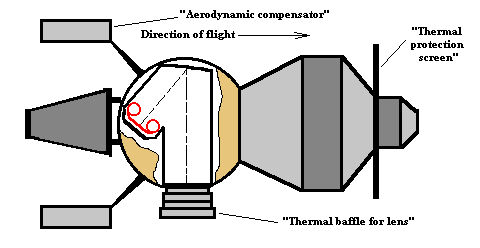

This sketch of a Soviet reconnaissance satellite is indeed baffling. There are several large groups of reconnaissance satellites with perigees around 170 km. Occcasionally lower perigees were used, but very seldom. Perhaps the 170 km satellites (Zenit 4M, Zenit-4 MK and Zenit 4MKM) looked like this. These satellites (Zenit-4M) usually shed a maneuvering engine just before the re-entry maneuver which was carried out with the main engine (on the right in the picture above). This maneuvering engine could be the conical structure on top of the re-entry vehicle. Calculations of the aerodynamic heat flux at 170 km altitude are needed before it can be ascertained that this sketch indeed shows the Zenit-4M(K)(M)-series.
The philosophy behind the Rotor system is (described in the Kozlov book) as follows:
"The continuous increase of the demand of consumers of photoinformation of high resolution was satisfied by the increase of the focal length. The limations of volume and mass for the useful cargo inside the SA (landing capsule) affected the design of the photoapparatus requiring a sharp bend in the optical axis in ordert o increase the focal length. However, this was not enough to achieve the required resolution, so designers decided to reduce the flight altitude.
This decision had repercussions on construction, components, on board systems, flight plan etc. The substantial aerodynamic forces at low altitude dictaed that the aerodynamic crossection of the spacecraft be kept low which was best achieved by keeping the longitudinal axis of the spacecraft aligned with the velocity vector. To compensate for the effects on orbital velocity and parameters from aerodymanic braking a multi-ignition correction engine (KDU) was used.
To minimise fuel consumption an elliptical orbit was used with photography carried out the minimum possible height, i.e. near perigee. In order to minimise perturbing moments from drag that could disturbe the orientation and stabilization of the spacecraft at times of photography special aerodynamic compensators were used. For protection against molecular heating at perigee, parts of the spacecraft had thermal shields and high efficiency thermal regulation systems. To maintain the thermal stability of the optics a sun-shade cover (krishka-blend) which opened only at the moment of photographing was installed. "
![]()